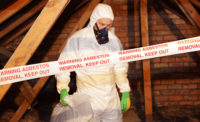During my career in OSHA I have had the opportunity to inspect many workplaces in many different industries. There are several lessons I want to share. First and foremost, to comply with OSHA regulations, you must read the regulation to ensure that you are complying with all requirements.
Why OSHA regulations may not make sense
One of the first things I learned in graduate school was that “Regulatory science is science under stress.” OSHA health regulations are based on industrial hygiene, toxicology and epidemiology sciences, but at the end of the regulatory process, they are a political compromise between what OSHA and labor unions want and what industry associations [don’t] want.
Some are overprotective while others may not be protective enough. When OSHA published its Hexavalent Chromium standard in 2006, it was accused by industry associations claiming that the standard was overprotective and by labor unions claiming the standard was not protective enough. I guess they cancelled each other.
The first compliance trap health and safety professionals must avoid is the natural tendency to apply their own professional judgment. Let me introduce Karl’s principle number 1: “If it makes sense to you, it may not comply with OSHA.” When OSHA says the employer “will, shall or must” do something, it is mandatory. If you think something in the regulation is unnecessary and you do not comply, your employer may get a juicy citation and fine.
OSHA substance-specific standards mandate the employer to conduct “exposure monitoring” for the 8-hour Time Weighted Average exposure (the Permissible Exposure Limit, PEL) or the Action Level. Some standards have a Short-Term Exposure level (STEL) or, in the case of asbestos, a 30-minute Excursion Level. Let’s look at the standard for methylene chloride as an example of exposure monitoring requirements. The employer (I mean, his industrial hygienist) has to conduct initial exposure monitoring (initial determination). The standard specifically requires personal breathing zone air sampling (area samples don’t count since they may not represent actual employee exposure). The exposure monitoring is conducted for at least one or more employees in each job classification in a work area during every work shift. Sample employees who are expected to have the highest substance exposure. In the case of methylene chloride, the employer must also sample for the STEL.
Periodic monitoring is an area where citations are issued for non-compliance. If the result of the initial monitoring is above the PEL, the employer needs to continue monitoring every three months. If initial monitoring is below PEL but above the action level, continue monitoring every six months. If initial monitoring is above the STEL, continue monitoring every three months.
What is not clear in the standards is that the employer should implement engineering controls so when two consecutive air sampling results, obtained at least seven days apart, are below the action level or STEL, periodic monitoring can end. There are other requirements in this standard that are beyond the scope of this article.
Case study 1: Asbestos abatement in the cab of a train locomotive
I conducted an inspection at a facility that maintained train cars and locomotives as a result of an employee formal complaint that employees had to remove asbestos without appropriate PPE. Non-friable asbestos-containing material (ACM) lining the walls of the interior of the train locomotive was removed by employees breaking it in small pieces, using power tools, without wetting the asbestos.
The corporate industrial hygienist reasoned that non-friable asbestos was not as dangerous as friable asbestos (that can be pulverized with pressure of the fingers) and the requirements of the OSHA asbestos standard did not apply.
The OSHA Area Director disagreed.
The problem is that, when non-friable asbestos is broken with power tools, fibers are released. The asbestos standard has no exemption for non-friable asbestos removal. The employer was cited for not conducting exposure monitoring, not wetting the ACM prior to cutting with power tools, not providing required training to affected employees (i.e., not providing a copy of the OSHA asbestos standard to employees) and not offering smoking cessation classes to employees conducting asbestos abatement.
Case study 2: HAZWOPER response at a chemical manufacturing plant
OSHA was informed of a chemical release at a chemical plant. The company had a total of 23,000 employees in several plants in several states. A 1,400-pound bag of a new product which was an ingredient for soaps was off-gassing. The safety data sheet identified products of decomposition as chlorine and hydrogen chloride.
Two employees, members of the emergency response team, put on full-face air-purifying respirators, and, with a forklift, took the smoking bag outdoors. One employee drove the smoking bag around the building. He drove in reverse to have the smoke move away from his face (good thinking). At the receiving bay, the bag was doused with a solution of water and caustic soda until it stopped smoldering.
The problem I found was OSHA’s Hazardous Waste Operations and Emergency Response standard (1910.120(q)(3)(iv)) requires the use of a positive pressure self-contained breathing apparatus. Air-purifying respirators are only allowed if exposure monitoring determines that concentration of air emissions will not exceed the protection factor of the respirators. Air-purifying respirators should never have been allowed for initial response to an incident involving a cloud of potentially toxic gas. If the employee driving the forklift had not ensured the gases moved away from his respirator, he might have suffered an acute exposure.
I learned the employer previously had been cited by OSHA for the same violation at another plant two years earlier. OSHA cited the company with a repeat violation with a proposed penalty of $12,500. The EHS manager did not identify the deficiency in his emergency response plan prior to the incident and was not aware of the previous citation. Lesson learned: Corporate EHS managers must inform all their sites of any OSHA citation to one of their plants to prevent repeat violations.
I can share many other experiences with you but I need to keep this article within limits. I hope that I made clear the importance of keeping your professional judgment in check and carefully reading the OSHA regulations to make sure your site is not in violation.



